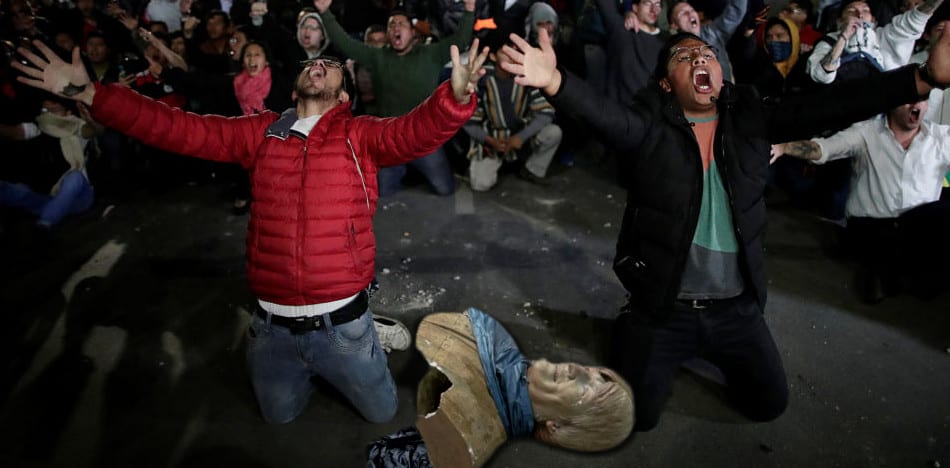
Evo Morales’ political career had its start as well as end in Cochabamba. A statue of the now-former president of Bolivia was hammered down in the municipality of Quillacollo, Cochabamba, the same department where he emerged as a union leader and where he took refuge before escaping the country after committing fraud in the last presidential elections.
The repudiation of the Bolivians is not limited to the former president. In October 2019, amid protests unleashed by Evo Morales overturning the second round of elections, Bolivians from the eastern region toppled a statue of Hugo Chávez.
After all, it represented what Bolivia was like during the three terms of Evo Morales: a satellite of 21st-century socialism.
Derriban una estatua de Hugo Chávez durante protestas en Bolivia
El pueblo latinoamericano no puede seguir viviendo bajo la dictadura de estos salvadores de la nada, que solo les engañan y ofrecen pobreza y miseria, a cambio de vivir ellos como reyes.
Muerte al socialismo! pic.twitter.com/JwnhdcpOBO
— No Habrá Paz † (@_SantosTrinidad) October 22, 2019
The destruction of Evo Morales’ bust happened hours after he, via radio, summoned Venezuelan-style armed militias to return to Bolivia. Evo’s fourth election, which was against the constitution, was already a source of a latent fear of becoming a Venezuelan-style tyranny.
People vigorously reacted when they heard Morales himself say that he would use the same methods as in Venezuela to stay in power.
Bust of Evo Morales destroyed in the cradle of his political career
The highlight of the destruction of Morales’ bust was the location. Cochabamba was where Morales emerged as a union leader. Morales’ road to the presidency was through the union similar to Lula Da Silva, the host of the Sao Paulo Forum.
Even as president, Morales never stopped playing soccer, a sport that led him to launch his political career. In 1981, Evo was appointed the sports secretary of his union. Four years later he became general secretary. By 1988, he was already an executive of the Federation of the Tropic. Since 1996, he has presided over the coordination committee of the six federations of coca growers, the most prominent in Bolivia.
?RETIRAN IMAGEN DE EVO?
En Cochabamba, #Bolivia, retiran el busto del exdictador @evoespueblo. ?
El pueblo boliviano quitando todo vestigio de criminal comunista, ese criminal prófugo de la justicia. ✊
Aprendamos América. ¿Quién sigue, Ortega o Maduro? ?#BoliviaLibre pic.twitter.com/IlfllUWlV7
— Cheva Patriota (@29Cheva_Patria) January 13, 2020
That is where he launched his career as a member of parliament in 1997. It was as a legislator that he actively campaigned to break the stigma against coca, an industry he defended before the UN in 2016 so that it would be removed from the list of narcotics.
His links to the area and industry remained strong until the day he left the country. Evo was last seen in Lauca Ñ, a community 171 kilometers from Cochabamba, where the headquarters of the coordinator of the coca producers are located.
But now that he has fled the country his support is waning. Things have escalated to the point that the region that saw his birth as a political leader is the same one that today, rejects him so much that they destroy his statue.
Cochabamba made it clear that Evo Morales is no more welcome, much less if he comes along with a paramilitary force.
Neither he nor the legacy of Hugo Chávez is relevant today in Bolivia, according to the protesters.
 Versión Español
Versión Español













